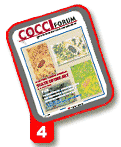COCCI FAQs
SPAH's technical service team answers questions about managing coccidiosis
Q. IS IT TRUE THAT THE USE OF THE COCCIDIOSIS VACCINE CAN RESTORE THE SENSITIVITY OF TRADITIONAL INFEED COCCIDIOSTATS?
A. Yes. In fact, when used over
time, the live oocyst vaccine actually
helps to convert resistant field strains to
strains that are more susceptible to traditional
in-feed coccidiostats.
The ability of the vaccine to restore
the effectiveness of in-feed coccidiostats
was demonstrated in studies
conducted at the USDA. Oocysts were
isolated from litter samples in houses
with broilers that had been vaccinated
for five flocks with Coccivac-B. Oocysts
also were collected from litter in houses
with non-vaccinated birds treated
with ionophore coccidiostats.
Next, one group of specificpathogen-
free (SPF) birds was challenged
with oocysts from the vaccinated
houses and another group of SPF
birds was challenged with oocysts from
the ionophore-treated houses. During
the challenge, all birds received 60
ppm of salinomycin in the feed.
Comparison of the two groups
revealed that isolates from the vaccinated
houses were fully sensitive to salinomycin,
while isolates from non-vaccinated
houses varied in the degree of
sensitivity.
In another trial, oocysts isolated
from litter in a broiler house before
immunization with the vaccine were
compared to oocysts in litter from the
same house taken after vaccination of
one flock. Vaccination restored salinomycin
sensitivity by seeding the house
with coccidia that are sensitive to infeed
coccidiostats.
Q. IN TERMS OF MANAGEMENT, WHAT CAN I DO TO OPTIMIZE PERFORMANCE OF A COCCIDIOSIS VACCINE?
A. There are several steps that producers
can take to optimize the performance
of coccidiosis vaccination.
Food and water given before or
after vaccination should not contain
anticoccidials or other drugs that could
have anticoccidial activity. Oocysts provided
by the vaccine could be
destroyed, thus preventing the development
of immunity.
Good sanitation is important
because it reduces the chances that
vaccinated birds will be challenged by
coccidial organisms. We suggest removing
litter and thoroughly cleaning houses
in between rearing cycles.
Other management methods that
can improve the performance of coccidiosis
vaccination include lower bird
density, breeding practices, controlling
access to soil and reducing litter moisture.
The litter used in houses should
be absorbent, such as wood shavings
or rice hulls. Straw does not absorb
moisture well.
Q. WHAT STEPS SHOULD BE TAKEN IN THE HATCHERY TO ENSURE BEST RESULTS WHEN ADMINISTERING A COCCIDIOSIS VACCINE?
For starters, always follow proper
vaccine mixing procedures. This
includes following the manufacturer's
mixing chart for correct amount of distilled
water to vaccine, using the correct
amount of dye (so you can spot
any missed birds), and maintaining
constant mixing of vaccine while it's
being sprayed. Visually inspect the
Carboy bottle to make sure the vaccine
is being stirred.
You also want to make sure the vaccine
is being properly administered.
Conduct daily dosage checks and
check the spray pattern on the chick
box. If spray pattern from the nozzle is
not even across box, remove the nozzle
and clean or replace.
Lastly, always let birds sit for 20 to
30 minutes in a lighted room before
loading for delivery to allow them time
to preen and dry.
[Note: If you suspect any problems,
contact Schering-Plough Animal
Health's hatchery equipment department
immediately at 800-531-0091 (U.S.
only) or your local representative.]
Q. WHY DO COCCIDIOSIS VACCINES CONTAIN MORE THAN ONE SPECIES OF COCCIDIA?
A. Immunity to coccidia is species
specific. Therefore, immunity developed
against one species does not provide
cross protection against a different
species. For example, vaccinating or
exposing birds to only E. tenella over a
period of time will provide immunity or
protection only to further challenges
against E. tenella. In order to provide
broad protection against coccidiosis,
vaccines contain all the species considered
pathogenic to poultry.
Q. MY HATCHERY PRODUCES BIRDS THAT ARE DESTINED FOR MORE THAN ONE COMPLEX. IF I VACCINATE BIRDS FOR ONE COMPLEX, IS THERE A DANGER OF EXPOSING THE BIRDS DESTINED FOR THE OTHER COMPLEX WITH COCCIDIA FROM THE VACCINE?
A. There is no danger of creating a
problem with cross-contamination at
the hatchery. The complex not using a
coccidiosis vaccine will be using a coccidiostat
for coccidiosis control. Live
vaccine oocysts are highly sensitive to
anticoccidials, so even if 1-day-old
chicks are exposed to a full dose of the
vaccine by accident, the vaccine will be
eliminated by the coccidiostat in the
starter feed.
Q. DO I HAVE TO ROTATE COCCIDIOSIS VACCINES WITH ANTICOCCIDIALS?
A. No. Vaccines can provide yearround
protection without the buildup
of resistance associated with anticoccidials.
In broilers, some companies
choose to rotate the vaccine and anticoccidials
"perhaps three cycles with
vaccine, two with a coccidiostat "due
to cost (small birds) or to field-management
conditions that make vaccine
reactions more difficult to control in
cold weather.
Q. CAN COCCIDIOSIS VACCINE BE USED IN WINTER?
A. Yes. Coccidiosis vaccine can be
used in any season as long as moderately
dry litter conditions can be maintained
and stocking density can be
managed to control the vaccination
reaction. Some companies find it difficult
to use coccidiosis vaccine in winter
because ventilation is reduced and
birds are held in the partial house
longer than 14 days.
Source: CocciForum Issue No.4, Schering-Plough Animal Health.







